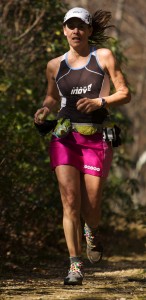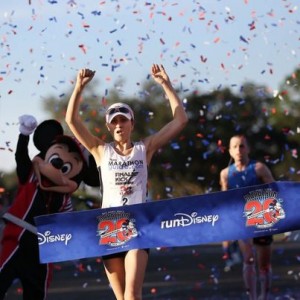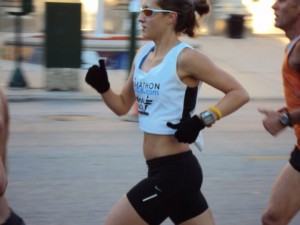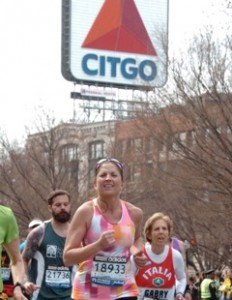Rebekah Trittipoe vividly remembers the 160-mile Brazil Jungle Marathon back in 2003: Six days of racing alone in the hot and humid Amazon made the veteran runner stronger, both physically and mentally.
“It was an amazing experience,” said 56-year-old Trittipoe. “That was really a big step for me. I would love to do it again.”
BRAZIL JUNGLE MARATHON
Different from other ultramarathons she has run in the past 10 years, the six-stage Brazil Jungle Marathon was self-supported, and Trittipoe had no idea what to expect or how to prepare for it; the only thing she knew was that she wanted to do it. “I was very excited, because I’d been looking for something people would call crazy and stupid,” said Trittipoe.
After saying goodbye to her husband and children, Trittipoe was on her way to another hemisphere with a back- pack filled with food packages, two pairs of socks, and some clothes.
Armed with only the backpack, a map and some water, Trittipoe began the adventure with another 40 athletes from all over the world. “Even though it was called marathon, it’s really hard to run because you carry all your supplies; I felt like I was a turtle with all the things on my back,” she recalled.
In the pungent 100-degree jungle, Trittipoe got wet by hiking through swampy areas. Some people developed funky skin rashes on their legs. “Every time you went through a swamp, you thought, ‘Oh my goodness, what’s in there? Would it eat me?’ ” she said.
At one point, Trittipoe found herself lost in the jungle when the red ribbons tied along the not-so-established trail disappeared, and the map was not really helpful. “I had no idea where to go,” she said. “It was really frustrating. I was yelling, ‘God! I need some help!’ ” Luckily, a man heard Trittipoe and got her back on track.
At another point, she was the helper: Trittipoe shared water with a woman from England who had completely run out. Trittipoe herself was dehydrated and exhausted, which made it even harder to race. “One of the things I learned from the Brazil race is that you have to be very, very flexible, because what you might expect to happen doesn’t always happen,” she said. “Sometimes you just have to suck it up and deal with the cards you’re handed and do what you can.”
Trittipoe and the other runners camped near water every night. She cleaned herself and washed the clothes she was wearing and hung them up. Darkness came quickly in the jungle; there was nothing to do other than organize stuff for the next day and chat with fellow athletes, then try to get to sleep in the noisy outdoors. “You would think the jungle is quiet, but it’s not. It’s very loud. You get used to it,” said Trittipoe. In the morning, they woke up early and retrieved their not-quite-dried items and put them back in their packs. A new day began again.
“You certainly went through phases you hated, because it was so difficult and you were suffering. I just could not allow myself to come that far, flying all the way from a different continent, to quit. I had to finish it,” said Trittipoe.
Six days later, Trittipoe got to the finish line. She was the first American to finish the race, and second overall. “All I wanted was an ice-cold Coke,” she said. “The world became wonderful again. I finally could get a shower. It’s wonderful to have a clean bed to sleep in and a room with air conditioning.”
RUNNING CAREER AND LIFE
Trittipoe had been an athlete since high school, where she played hockey, volleyball, and tennis. And yet she never thought of running long distance until she was 36, and challenged by well-known ultrarunner David Horton that she would not be able to run 50 miles. “I thought ‘Fine, I’ll show you.’ That’s when I started running and training for long distance,” recalled Trittipoe. Her first race was the 1994 Catoctin Trail 50K—and she won.
Trittipoe suffered multiple injuries on her feet and ankles for the first five years. After going through the hardships, she adjusted her training and hasn’t been injured since. “There’s always difficulty,” she said. “I had to train in a way that is good for me. I can’t do 80, 90, or 100 miles per week. And you also have to figure out what suits your life situation. My highly stressful medical career was really demanding on my time. I had to readjust my priorities to make sure I keep everything in balance.”
Trittipoe is a mother of two sons and lives with her husband in Bedford, Va. She doesn’t race as much as she did before, but she still runs ultras and trains three days a week. Once a cardiovascular perfusionist, she often found herself swamped with medical cases. She is now coaching a high school cross-country team and also teaching biology.
“Yesterday I took the cross-country team on a one-night running trip. These kids can run 17 miles now. Most of them didn’t run that much before. They embrace the idea of going out to the woods and running long miles and climbing mountains. It’s very rewarding to see them go from the impossible to the possible. I want them not just to be athletes, but to be stronger,” said Trittipoe.
She has run more than 80 ultramarathons over the years, including Catoctin 50K, Mountain Masochist 50 miler, JFK 50 Miler, The Groundhog Classic 50 Miler, Rattlesnake 50K, and the Uwharrie 40 Mile Mountain Run. She was one of six women to complete The BEAST ultramarathoning race series; was the women’s record-holder on West Virginia’s 302-mile long Allegheny Trail (7 days, 6 hours); and was the tri-holder of the women’s record on the South Beyond 6000, a nearly 300-mile long run across 5 mountain ranges with the summit of 40 peaks in excess of 6000ft. elevation (6 days, 13 hours, 31 minutes).
“I like running because I like the place it takes me,” said Trittipoe. “There are so many beautiful landscapes that can only be seen from the top of the mountain. Do I love running every day? No, I don’t. Sometimes I hate it, because you feel like crap. But you have to take the step, you have to get through those days.”
Rebekah Trittipoe is also a writer who has published four books: “Best Season Yet: 12 Weeks to Train,” “Pace Yourself,” “Under an Equatorial Sky,” and “A Quest for Adventure.” For more information, visit http://rebekahtrit- tipoe.blogspot.com/
Alexander Cochran doesn’t see himself as a runner, though he enjoys running and has completed seven marathons. His goal is to run the Boston Marathon—or to have a post-race beer.
“I won’t run Boston until I qualify,” said 46-year-old Cochran, special counsel to New York State Gov. Andrew Cuomo. “It’s a special race. In fact, if I never ran Boston but still hit the qualifying time, I’d die a happy runner.”
BOSTON STRONG RUN
Three years ago, after going through a training program and being coached by a sports therapist, Cochran was so close to the BQ (qualifying time)—but he missed it by four minutes. “I cried like a baby,” he recalled. “Now, since the bombing, I am doubling down on training so that I can run it with my friend who was almost blown up.”
The friend Cochran refers to is Jamie Hoag, who ran the Boston Marathon for the first time this April. When Cochran saw the breaking news on MSNBC, he was concerned about Hoag and hoped for the best. Luckily, Hoag was fine, and sent Cochran a picture from between the two clouds of smoke.
Cochran later had the idea of setting up a run in Hoag’s honor. “I mean, he trained his ass off for four months and was 100 feet short,” said Cochran. “The idea was to run with Jamie and let him finish the run. We would raise money for the One Fund Boston and maybe also an injured runner, and make the terrible experience a better one.”
The run was called Boston Strong Run and set up with three different distances: 5 kilometers, 4 miles, and 8 miles. Not only did Cochran recruit 4POINT4, a philanthropic brand of sports apparel, to donate shirts to all the runners, he also spent 12 hours with his child making little finishers’ medals out of Shrinky-Dinks. The medals were blue on top, gold at the bottom—the same colors as the Boston Marathon—with each runner’s initial emblazoned on a medal. Cochran asked friends of the running club and all the New York State con- gressional delegation staff to participate in the Run. The goal was to have 25 to 50 runners and raise $1,000.
On June 15, 75 people ran together at Carderock Park, Md. They raised $2,500, and contributed half to the One Fund and the other half to a runner from Boston who lost both legs in the blast. “This is an opportunity for them to connect to people in Boston and to Jamie,” said Cochran.
EARLY RUNNING EXPERIENCE
Cochran hadn’t started running until 10 years ago, when his wife Teresa was pregnant. Like many dads-to-be, Cochran was both excited and worried, and wondered if he could be a good father. So he put on running shoes—which he had bought for the bright color, not for performance—and went out for a run in the August heat. Running cleared his head and made him feel relieved. He did it again the next day.
“I never thought I could run a marathon. That seemed crazy. Then I thought of all the hell my wife was going through being pregnant; and I decided if she could do what she was doing to have a baby, then I could work up to a marathon,” said Cochran.
Moved by watching his brother run the Marine Corps Marathon three times, Cochran decided to run his first one—the Baltimore Marathon. “I did the math and hoped I could go from 60 minutes to 4 hours in 10 weeks,” he said. “It wasn’t easy, but I used my wife as inspiration and gutted it out. I made it through and ran a 4:08 pace—and I was hooked.” Cochran has since run seven marathons. His pace has improved to 3:25.
ALMOST RUNNING CLUB
Cochran enjoys running, and also tries to encourage friends to get off the couch and start running. So he founded a neighborhood running group called “Almost Running Club.”
“Everyone has an excuse for why they can’t run,” said Cochran. “So I want to create an excuse for them to run. Don’t tell me you can’t—because you can bring your kids to my house, and either my wife or I will watch them. You can run whatever distance you want, 2 miles or 10 miles. Later we will have champagne, beers, bagels, or whatever. It will be a party.”
Beginning with only 10 people, the club has grown to 30 over the years. They run on Hallmark holidays and play with the “Almost” theme: A run on Valentine’s Day is called “Almost in Love”; a run on Christmas is “Almost Frosty”; a run on Thanksgiving is “Almost Stuffed.” Every runner has a funny “Almost” nickname; Cochran got the nickname “Almost Well”, as he’s always injured by running. “We have a Boston Red Sox fan, so we call him ‘Almost Yankee’,” Cochran laughed.
“I tell you, of all the things I’ve done professionally—from law school to politics to passing the Hurricane Sandy Appropriations Act—the most gratifying thing I’ve done, with the help of my Almoster buddies, was motivating folks to get off the couch and run,” said Cochran.
Besides running together, the “Almosters” exchange daily emails to motivate each other. “At the end of the day, it doesn’t matter whether you are a runner, a jogger, or a walker,” Cochran said. “As long as they are getting out there, no excuses, and doing it, I’m proud of all of them—and hopefully I can be proud of myself. ”
JEFF BAUMAN
Jeff lost both legs in the Boston Marathon bombing. We gave him $900 and the other $1,600 went to the one fund. We wanted to have a direct connection with part of the money as opposed to just giving it to the fund so the cash that was given went to me went to Jeff and his beautiful story. the folks that wrote checks went to the fund. so with a little check to Jeff we say thank you to not only him but all of our own individual support networks for putting up with the craziness of trying to be a runner.
My name is Francene Johnson, and I’m from Joplin, Mo. I’m a wife, mom of three, blogger, assistant track coach and marathoner. I was born and raised in Lorain, Ohio. I was a sprinter from elementary school up to junior college, and during that time I won five state competitions. I also ran cross-country in high school to better my endurance in the 400-meter dash, and because of excellent performance, had the privilege to compete in China with other top cross- country runners from the U.S. in a 13K race. I placed 22nd out of the top 50 American girls.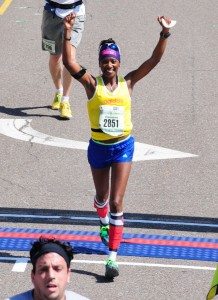
I received a full track scholarship to NEO A&M Junior College. After my first year, the school cut the track program. When that happened, I moved to Joplin and got a job as a waitress at Shoney’s. I didn’t run from 1991 to 1996; then I entered the Show Me State games to run a 100-meter dash. Since I was the only one in my age group, I won my age class.
Skip forward to 2011 when my husband and I had a family. Randomly, in April 2011, I received an email saying that I was going to be inducted into the Lorain County Track & Cross-Country Hall of Fame. I was super excited, so we drove to Ohio for the induction. It was such an honor—and that is one of the main reasons I was inspired to get back into running.
In December 2011, I stepped out onto the street with my stop-watch from track and timed myself running a mile. The first two blocks was a killer. I was out of breath, and it hurt! I hadn’t realized how out of shape I was! I kept a journal and logged how long it took me to run a mile each day I ran. A few days later I learned about the running app, Mapmyrun, so I started using that to help log my runs; it kept track of my miles, pace, calories burned, etc. In the back of my mind, I had hoped to keep this going. I had always been excited about starting something new; but with many other things, after the newness wore off, I didn’t stick with it. However, it was different with running.
In January 2012, I signed up for my first 5K race since high school and placed first in my age group. It was so encouraging that in March 2012 I ran another 5K—and this time I was the first over-all female!
I felt I was on a roll and would run a few more 5Ks; but then the idea of running a half marathon crossed my mind. I wondered if I could ever run that long. I researched half marathons and training programs, and in the summer of 2012 I decided to run a half—which required I run up to at least 10 miles in training. On Sept. 29, 2012, I ran my first half marathon in Kansas.
I’d tried to figure out what my time would be; my husband guessed that I could probably do it somewhere around 2:05 or so, based on my 10-mile average pace. The race in Kansas was a small race, so I didn’t feel a lot of pressure;
I just had to remember not to take off fast! I ran an 11- mile pace for my first mile, and then started to pick it up. I could see the number of females in front of me and was slowly passing them as the race went on; I felt good about that. I started to count the females; I remember about four of them being in front of me at mile 6 or so. I kept a pretty good pace for the next few miles.
I remember a guy yelling to me that I was the fourth female and at the same time seeing a girl in front of me, close enough for me to catch. I had gone into the race thinking, “I’m not going to be competitive, I’m just going to run for fun and see how this goes.” So much for that. I passed the runner in front of me; and while the last two miles of the race seemed like they took forever, I finished in 1:55:09, third overall female.
I remember crossing the finish line thinking, “I’m a half marathoner.” I was interviewed because the event organizer heard it was my first half marathon—and placing 3rd was great! I loved the half so much that I ran another three weeks later, placing second in my age group. Three weeks after that I ran my third half, where I got a PR of 1:50.
I never thought running that long of a distance would be so much fun, but it has been and I happen to be doing well with it; but as with most things, you get to thinking, Can I run a full marathon? Frankly, I had no time for training for something that long. I was a busy mom, and assistant track coach—but I researched how to train for the marathon anyway. I knew I wouldn’t be able to follow a certain training plan; I’d have to do it my way.
Weeks went by, and in December of 2012, I started training for the Little Rock Marathon to be held in March 2013. Training went well, but one week before the marathon I came down with a fever. I couldn’t believe it. The fever lasted on and off for a week, and I wasn’t sure I’d be up for the marathon. I knew there would be more marathons, so I wasn’t disappointed; and my husband and I travelled to Little Rock that weekend anyway so that I could get the feel of what it would be like and so we could cheer for friends who were running. It was an inspiring weekend for sure.
The following weekend I signed up for the Oklahoma City Memorial marathon, six weeks away. I thought that was plenty of time for me to get ready for it and started my training over again, running 15 miles or so and adding a mile the following weeks. Marathon Day arrived; it was a beautiful morning and I was eager to run. I didn’t feel any pressure because I knew I was going to be running at a slower pace.
Running the OKC Memorial was emotional; it was just weeks after the Boston Marathon bombing, and athletes wore the names of the victims on the back of their shirts. People were also wearing blue and yellow ribbons in memory of the Boston victims. Firefighters were walking on the course. People were patting them on the back, saying “Thank you” as they passed them. I did the same. There was so much crowd support all along the course; it was AMAZING!
I didn’t hit the wall at mile 20, so that was nice; I did, however, feel some pain at mile 22 and I just wanted to get the race done. It was hot. The temperature was in the mid 80s or so, but I would finally get through the 26.2 miles at 4:21. My legs were on fire, but before I left the race I knew I would run the marathon again. I enjoyed it!
My next marathon will be in November 2013 at the Bass Pro Marathon in Springfield, Mo. This is where I ran my second half marathon. Recently, I considered running a 50K, and so I am looking into running one of those 31-miler races. I love the challenge! I know I can do it, and I will do it!
“I sometimes run with our local running group—The Run Around, LLC—the people I run with have pushed me; I recommend running with a group.”
I train on my own most of the time, but sometimes run with our local running group—The Run Around, LLC—on Wednesday nights. The people I run with have pushed me; I recommend running with a group of runners any chance you have. I enjoy the social part of it as well.
TRAINING/PRODUCTS
My running gear consists of Brooks Pure Connect shoes, New Balance Minimus, and Skora running shoes; headbands by Bondi bands and Sweaty bands; Lunatik Athletik Compression Socks; moisture wicking clothing from The Run Around, LLC in Joplin, Swirl Gear, Run Girl Run; funky compression tights from Nike; moisture wicking tops from Danskin; and my GARMIN and Mapmyrun app.
I drink lots of water and enjoy eating Chobani yogurt, fish, avocados, spaghetti, hard boiled eggs, salads with fruit and pecans, fruit smoothies, chocolate protein shakes by Arbonne, roast with rice, and chicken. I drink coffee, and will have a cup before a run.
My husband is a chiropractor and so he is my sponsor. I get all my chiropractic care from him and really appreciate all he does for not only me, but also other athletes in the community.
In addition to being an assistant track coach, I do some high school senior and family photography, and volunteer in the community with my photography as well. I have a blog at irunlong.blogspot.com and also enjoy my facebook runner blog, I Run Long at facebook.com/irunlongalways. I train anywhere from 25-35 hours a week and have started to throw in some biking as cross-training.
MENTAL TRAINING
What drives me in my training is to remain consistent, staying hydrated, alternating my routes. I love running along busy roads. I enjoy the encouragement from motorists, the waves and honks. I usually see friends and other runners out, and that is such motivation for me.
BUDGET
I have not budgeted for my races, but I really need to; there are just too many races that I want to do, and I know that I cannot afford to run them all. I try to pick a couple a month to do, but I still put extra races on my calendar just in case (ha!). I had this brilliant idea of having a T-shirt made and asking friends and family if they would like to sponsor me at $50-$75 to have their business logo put on the back of my running shirt to advertise their business and also promote them on my blog, and they would have the option to buy a shirt. I haven’t started the project or even shared the idea with anyone else, but I will soon. I think it sounds like a great idea! I’d donate money to have my business advertised.
PAIN/INJURY/SETBACKS
Since I got back into running, I’ve had a couple of setbacks. The first one was a strained groin muscle. I hated not being able to run. I laid off running for two weeks and kept up with my chiropractic care and stretching. The first setback happened early on in my marathon training. I do believe in rest; the body needs rest. I do not train every day, but maybe four to five days a week. I fell out of routine after my marathon, but I’m getting back to where I need to be. I recently felt a little pain in my left knee and thought, “What is going on?!” I believe it happened when I turned suddenly during a run because I was startled by large barking dogs behind me. But I’ve not had any serious injuries.
TRAINING TIPS
I love running on grass or a track surface. I feel it’s easier on the body; and running on grass, I believe, makes me a stronger runner. I also like to run hills—and here in Missouri, there are lots of them! I train on long incline hills near my house all the time. When approaching a hill in a race, I don’t look at the hill but look just a little in front of me, and I lower my head and pump my arms and talk to myself, saying, “What hill?” It sounds silly, but it works for me! I recommend a Garmin. It’s accurate; and being able to watch my pace on runs is a big part of my training. I am so glad I got one. There are so many cute colors out. I’m motivated by fun-colored clothing and gadgets. Whatever works, right?
PACER
I’ve had the opportunity to pace a group of runners at Joplin Memorial Run on May 18, 2013. I was asked to do it, and it was my first time. I got to do the 9:30 pace for the half marathon. My best was 1:50, and I needed to run it within 2:04:30. I was nervous about for weeks, knowing it was on me to get everyone back within that time. I didn’t have to be that nervous. The pace was a little slower than what I normally run, but I was nervous about the course because I hadn’t had a chance to run it before race day. I was accurate with my time, so I was happy about that! Next year I want to run the same race to compete. It was weird not to wear a chip timer or bib.
GEAR
I’m always talking about gear that I love and look forward to sharing with my readers, friends and family on facebook. I’ve had the opportunity to do some reviews, but for others I shared their product for no compensation. I actually had a company contact me recently about doing a review for their running shoes. I’m watching out for the shoes to come in the mail. I had raved about the Lunatik Athletik socks on my own, and later was actually asked if I’d like to do a review for a pair of their new compression socks. I would be more than happy to do a review for companies. I sometimes contact companies asking if I can do a review for them. Some don’t reply back, but a few have let me. So far they’ve all been great products!
During my training runs and my races, I always wear Lunatik Athletiks (lunatikathletiks.com) compression socks to control soreness and promote quicker recovery (and of course for style!).
REVIEWS/TEST PRODUCTS
“I would like to thank all the companies that have allowed me to review/test their products.”
Lunatikathletiks.com
Runningskirts.com
Mapmyrun.com
Rungirlrun.com
Headsupbands.com
Clickinmoms.com
Chobani.com
Skorarunning.com
Deucebrand.com
Manduka.com
Hipssister.com
Sweatybands.com
HOW SHE DOES IT
What drives me and keeps me sustained during competition is to remain focused on my race. I have to remember to stay on pace for the marathon and to be sure to stop at every hydration station.I cannot try to keep up with any runners who are running by me fast. I watch my pace and stick with that plan while enjoying the race. I don’t run with music anymore. the crowd is really what keeps me going. those cheers, smiles and the fact that they are out there all morning in the heat or the cold, motivating and encouraging the runners, is priceless. for my half marathons and shorter races, I have to go all-out. i try to run the first mile slower, but I’m so into getting a PR; and having a sprint running background, I love running fast and picking out someone ahead of me to push me. I don’t run in the middle of the course, but instead as far over as possible to keep from running extra mileage. if I’m going to be turning left ahead, I’ve already gotten over to the left side of the road so that i’m ready to turn left without crossing the road and dodging other runners. I have a very active and sporty family. My kids play softball, soccer and basketball, and run track and cross-country. My oldest daughter just graduated high school, and I’m pretty sure she will continue playing softball. My middle child, a 14-year-old boy, is super active and currently playing with a soc- cer summer league program; and my youngest, who is 8, plays on a traveling softball team on the weekends, bound for the 8 and under World series to be held in Alabama—plus she’s on a regular softball team that plays twice a week. We are quite busy! When my kids don’t have a game of their own, we love to travel an hour to springdale, Ark., to watch the Minor league northwest naturals baseball games. We have done that for about three years now, and it is so much fun. We enjoy bike rides, and at times I run while my youngest rides alongside me.
Virginia Beach runner Renee High won the Walt Disney Marathon for the second straight time in January 2013, in a time of 2:48:30. The Olympic qualifier took time to talk to us about how she loves running and stays strong.
ERM: How old were you when you made that first step to run marathons, and what pushed you down that path?
RH: I was 23 years old when I first met Jerry Frostick. At that time, he was the owner of Final Kick. He noticed that I didn’t really have a plan or a structured training for running, so he wanted to give me some direction. He sat down with me and began talking about my plans for running. He suggested I run the 2005 Shamrock Marathon, and offered to coach me for my first race. I thought he was crazy—but I was just crazy enough to believe him. It was his belief in me and his ability to motivate me that really made me think I could do the marathon.
I began my first marathon training program in January 2005. During one of my early long runs, I remember thinking that this whole marathon thing was crazy; but I kept at it. I never gave up, and I kept training.
I love training for marathon. It’s a tough race and it requires a lot of dedication. Training requires a lot of planning and attention to detail. It’s necessary to pay attention to everything, especially those things outside of the workout itself—hydration, nutrition, and how the body is handling the training.
ERM: How many marathons have you run so far? And can you tell us your favorite ones?
RH: I’ve competed in 13 marathons, and many of them are special for different reasons. My favorite marathon is my first marathon—2005 Shamrock. It was also the first marathon I won, and the first time I qualified for the Olympic Trials. It was painful, as I’d worn the wrong socks—rookie mistake. The socks slipped down inside my flats, and by the end my heels were bloody. I’d never been in so much pain, but I’d never been so happy. It was an amazing experience, and one I will never forget.
The Disney Marathon was also very special and very interesting. It’s so cool to be running through the park, because it’s such a unique place. When I was running there, it felt magical. I just loved the feeling of being in Disney World. And of course, the feeling of running in the Olympic Trials was indescribable. The emotions I felt from the crowd were overwhelming.
ERM: Tell us about your training. Who do you train with? What products do you use? Also, are you sponsored?
RH: I have an amazing training group of fellow athletes who are also wonderful friends, as well as a remarkable running community in Hampton Roads. I’m currently being coached by Jerry Frostick, now the owner of J&A Racing, and Ryan Carroll, a local accomplished runner. Together it’s like a small family, and the support is amazing. Love those guys!
I use Accelerade and UCAN for recovery. I really like them. I started using UCAN on the recommendation of Andriana Nelson Pirtea. I also use HUMA Gels during my long runs as a source of carbohydrates. They’re more natural and they settle better on my stomach.
I’m sponsored by marathonguide.com, and I’m an ambassador for J&A racing and its recently created LiveLoveRun Team. John Elliot, the owner of marathonguide.com, has been wonderful to me. He really provides a lot of support, which has been a godsend. Being the J&A ambassador is about being part of a family and providing support to the running community.
ERM: What is your family life like? How do you balance work, training and life?
RH: I have a wonderful boyfriend and we have two adorable dogs. I work for the University of Pittsburgh with Naval Special Warfare (though I live in Virginia Beach). I have a bachelor’s degree in nursing and a master’s degree in exercise science. I’m now finishing up another degree in nutrition, because I want to be a Registered Dietitian.
It’s a challenge to manage school, work, running and all my other training, plus my family and my friends. My boyfriend is very supportive, which is a big help. It also helps that the majority of my close friends are also athletes and are managing busy lives as well.
ERM: On your mental training: It takes a certain mental fortitude to do this sport. What drives you and keeps you sustained during competition?
RH: The marathon is a very tough race, mentally and physically. It can be challenging to stay focused for the entire race, even for the training itself, so it’s important to be able to refocus if my mind begins to wander. For me, I have to break it down. I never actually let myself think about the full 26.2 miles; in my mind, I break it up into different distances. It’s two half-marathons put together, or it’s 20 miles plus a 10k. I tell myself I can do anything for 1 mile, or I can do anything for 3 miles, or however I’m breaking it up in my mind.
ERM: What makes you keep running?
RH: It’s hard for me to describe how much running means to me, but I’m sure other runners get it. Running is about joy, beauty and personal accomplishments. The feeling I get after any run is amazing and euphoric. Running or training makesme a stronger person. Running has made me happier and better at all other areas in my life. I love running, and my love for running is really what drives me every day. I love the challenge that running represents: how deep I can dig inside myself to push harder or to keep going. For me, it’s always about improving myself and growing as a person.
Follow Renee High’s journey on her blog: http://reneehigh.com/
By Alix Shutello
It’s not every day someone randomly leaves a bar, runs 30 miles, and then qualifies for the Western States 100 after being drained to the bone in a 50-miler he just so happened to run. And while Dean Karnazes is known as the guy who ran 50 marathons in 50 days, he’s not just a marathoner; he is a seasoned ultra marathoner who has competed in some of the top endurance challenges around the world. This year, as he prepares for the Spartan Race World Championships, Karnazes took some time to give us insight into his training, racing, family and business life.
Dean Karnazes was your typical corporate employee with a nice salary and an easy lifestyle; but on his 30th birthday, after a few rounds of shots, one could say he experienced some clarity.
He left the bar and his buddies promptly at 11 p.m. and, like Forest Gump, just started running. He ran 30 miles through the night, even though he hadn’t run in a decade. Something drove him out of that bar and onto the roads; and it was then, on that night, that Karnazes’s life changed forever.
“After stumbling through the night running 30 miles, I thought that a 26.2-mile marathon was the longest running event that existed,” Karnazes said. “But then I learned about a 50-mile race. That sounded crazy to me, so I had to try it!”
The race, the Gibson Ranch 50, took a lot out of Karnazes. At the finish line, he saw some guys high-fiving each other in congratulations on qualifying.
“Qualifying for what?” Karnazes asked. They explained that they’d finished the 50-miler within the cutoff time to qualify for the Western States 100-Mile Endurance Run. Karnazes was shocked at the thought of running 100 miles. “I thought it was impossible,” he said. “How could a human possibly run 100 miles non- stop, let alone along a mountainous trail through the Sierra Nevada?”
The competitors told Karnazes he had qualified, too. “The thought of running 100 miles on a rugged trail through the mountains was the most daunting challenge I had ever heard of—so I signed up,” Karnazes said.
After successfully completing the Western States 100, Karnazes ran the notorious Badwater Ultramarathon—a 135-mile race through Death Valley coined, “The World’s Toughest Footrace.” From there, Karnazes graduated to a 200-mile 12-person relay race; only he ran it solo.
“It just got worse from there,” Karnazes said.
His next endeavor was to run 262 miles, or 10 marathons back-to-back as a fundraiser for a little boy awaiting a liver transplant. From there he graduated to 350 miles in three days of continuous running. He participated in 48 hours on a treadmill (as a fundraiser), followed by the event which made him famous: 50 marathons, in all 50 U.S. states, in 50 consecutive days, followed by a 3,000+ mile jaunt from Los Angeles to New York City.
Then came running across the Atacama in Chile, the Gobi Desert in Central Asia, the Sahara and Antarctica—just to name just a few of the places in which Karnazes has run and competed.
Karnazes’s sponsor, The North Face, has this terrific motto: “Never Stop Exploring”—a motto Karnazes lives by.
WORK/LIFE BALANCE
Karnazes is dedicated to living a full, healthy life, and realizes that there really is no balance other than what he can control in terms of diet and exercise.
“People sometimes ask me how I strike a balance in my life with family, work and training. If I said there was balance in my life, I would be lying. There’s no balance whatsoever. Things are frenetic, fast-paced and frequently disjointed; more akin to managed chaos than balance. But it all seems to work, and it’s a helluva lot of fun! I sleep only about four or five hours a night, so that’s beneficial for fitting everything in.”
When it comes to fitness, Karnazes does control his environment.
“I believe in total body conditioning as a way to build endurance and avoid injury. Along with running 80-120 miles per week, I’m cross-training by surfing, rock climbing and stand-up paddleboarding.”
Karnazes has a gym in his office that consists of a floor mat and a pull-up/dip/push-up bar. Throughout the day, he’ll cycle in sets of these exercises. He’ll typically do five-six complete sets each day, incorporating core and upper body strength exercises to help maintain proper running posture when the miles and exhaustion add up.
“Having an all-around strong body is critical for added stamina and injury prevention,” Karnazes said.
Aside from full body conditioning, diet and work environment are critical to his daily regimen and dedication to good health.
“I never sit. Sitting is the new smoking,” Karnazes added. “My entire office is set up at waist level, and I do all of my writing, emailing and phone calls while standing up. I feel much more energetic and alive when I’m on my feet all day as opposed to sitting on my rump.”
Running, to me, is the ultimate freedom. To keep things fresh and exciting, I sometimes don’t wear a watch when I run.
Karnazes’s diet is also extremely regimented. He has eliminated all refined and processed foods completely—no wheat, rice, oats or other grains, which can cause inflammation and joint pain. “I’ve also been eating cold-water fish all my life, principally wild Pacific salmon (which traditionally have lower mercury levels than fish from other areas), as omega-3 fatty acids are very beneficial for joint health.”
Karnazes describes his diet as a hybrid between Paleo, Raw and Mediterranean, and this, he’s found, is what works best for him. “I always counsel people to ‘Listen to everyone; follow no one.’ We’re all an experiment of one, and I encourage people to try new things to find what works best for them.”
A RUNNER’S PHILOSOPHY
It takes a certain mental fortitude to train and compete at the level Karnazes does. At the core, Karnazes is simply just enamored by running.
“Running, to me, is the ultimate freedom. To keep things fresh and exciting, I sometimes don’t wear a watch when I run. Instead, I just go for a run. It might be a short run, or it might be a long run (sometimes overnight). If you’re always wearing a watch and super-focused on racing, it gets a bit stale and can lead to burnout. Sometimes I train and race hard; other times I just hit the trails and enjoy myself, running simply for the pure joy of running,” he said.
“I love doing what I do. When people ask me if I’ll keep running forever, I tell them my finish line is a pine box. That said, if one day I wake up and no longer love running, then I’ll do something else. But right now the fire burns brightly, so I’ll keep on keeping on.”
KARNAZES’S RACING ACCOMPLISHMENTS AND FUTURE ENDEAVORS
Karnazes planned to run a few dozen marathons and ultramarathons in 2013, including his 10th Badwater, which had been a goal of his. Later this year, he’ll be competing in the Spartan Race World Championships.
To date, Karnazes has racked up a dozen Western States finishes and 10 Badwater finishes. Will he ever do those races again? He imagines so—but he also likes doing new things, such as self-supported multi-day races. “I won the 4 Deserts Challenge a few years back, and I really enjoyed the experience. I’ve also done 24-hour mountain bike races, tri- athlons, adventure races, long-distance paddleboard races, Muddy Buddies, and a few other ultra endurance events.”
To say Karnazes is accomplished is an understatement. With The North Face as his sponsor, they develop a competition schedule in late fall for the following year. Outside of that, if he’s in a place where there’s a marathon or an ultra nearby, he’ll sign up and do it as a training run. Karnazes explains, “I’m an ‘opportunistic racer’.”
By Tony J. Stafford II, Professional Pacer
Successfully pacing a marathon is essential to having a great race. Though there are sometimes uncontrollable factors (e.g., weather), by always having a plan in place AND sticking to that plan, you will alleviate some (if not most) of the pre-race anxiety for the marathon distance.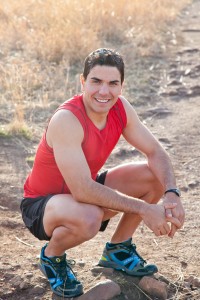
HERE ARE MY TOP FIVE TIPS TO EFFECTIVELY MAINTAIN RACE PACE DURING A MARATHON:
1. Know your ultimate goal marathon time, BUT ultimately know your splits—whether they be at each mile marker, every 5K or the halfway point. As a veteran pace leader, I still print out a “Marathon Pace Wristband” to ensure I’m hitting each mile close to the ‘target’ marathon time. Also, I DO NOT use a Garmin; I use my Timex watch so my body ‘feels’ whatever pace group I am leading.
2. Err on the side of taking the first half of the marathon slower. It is harder to ‘bank time’ rather than save energy for the later stages of the race. Runners get caught up in trying to be 10 OR MORE seconds faster each mile than their ‘target’ marathon time; in most cases, this results in burning all the energy and fuel toward the last 10K of a marathon.
3. Don’t be afraid to “power walk” through aid stations. I usually employ this strategy toward the second half of the marathon, when there is not as big of a crowd AND a runner may need a little break from the monotony of running 26.2 miles. I tell my pace group to grab water OR Gatorade, “get out of the way,” and walk while drinking. I usually suggest NO MORE than a 10-second ‘walk’ through every other second-half aid station.
4. Stay calm and controlled. If my pace group misses a split, I tell them not to worry; concentrate on breaking the distance down in small segments.
5. Run in a pace group. Research and find out about your pace leader. Pace leaders are professionals who selfishly help other athletes hit those goals!
HOW MANY MARATHONS I HAVE PACED?
To date, I have paced more than 40 marathons throughout the United States and Canada. The majority of marathon times that I pace are 3:05:00 (Boston Qualifier for Men 18-34) and 3:10:00 (Boston Qualifier for Men 35-39). This year I will be pacing the 2014 Chicago Marathon for the fifth time as the 3:05:00 pace time. After that comes the Richmond Marathon.
By Jeffrey Horowitz
Jeffrey Horowitz is a certified running and triathlon coach and a personal trainer. Formerly an attorney, Horowitz quit law to pursue his passion for endurance sports. In this article, the expert shares tips from his second book ,“Smart Marathon Training,” on how to train better and run smarter.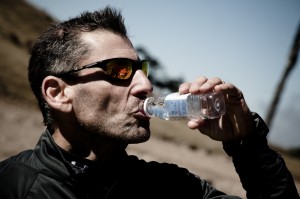
I first started running as a way to relieve the stress of grad school. I ran my first marathon in D.C. back in 1987. It really helped me define myself and get focused. I just loved that. I’ve now run 171 marathons, at least one in every U.S. state and all around the world. I had so many really extraordinary moments that became the most important parts of my life, and I’m able to share with other people and help them realize their dreams.
SET A REALISTIC GOAL
The thing about the marathon is that it’s a great challenge, and I tell people to be realistic about their goals. There are some concrete rules of thumb about setting goals.
First of all, you should follow what we call “the rule of 10 percent,” which means from one week to the next, you should not increase your overall mileage by more than 10 percent. Give yourself enough time to build up slowly. That way, the chance that you’ll successfully run a marathon will be much greater and you’re less likely to get hurt. I recommend using shorter races to get an indication of where you are. You can occasionally do a couple of 5ks, 10ks, may be even a half-marathon as part of your buildup. If you run a half-marathon at an eight-minute pace, you can feel pretty confident that you can run a four-hour marathon. On the other hand, if you feel it is difficult to maintain a nine-minute pace, you may need to be realistic about your goal. So setting benchmarks throughout your training, where you can see where you are physically, is really a good idea.
GRADUALLY INCREASE DISTANCE TO AVOID INJURY
To gain endurance, you need to log miles in order to improve, however, as we run we also tend break down, so it’s prudent to work on strength exercises too. The research shows that the benefits of running top out around 35 miles per week, therefore, running daily may not work for some when it works just fine for others.
For those who run 50 miles per week, the chance that you’ll get an injury increases dramatically. So you need to preserve yourself and also do other things that complement your running to make you a healthy, injury-free athlete. That’s what “Smart Marathon Training” is about. You should have a goal in mind and be very targeted to reach that goal. That’s what I call purposeful training.
TRAIN SMART WITH ECONOMICAL APPROACHES
When you run, you’re on one foot and your body is twisting. It is a position that increases instability. If your body is not strong enough to hold your form, that could lead to injury. Find ways to build your body and make it strong enough to hold the form as you run. Research shows that cross training, like cycling in particular, works complementary to your muscle groups. The same holds true with strength training. So workouts that involve swinging or unstable position holding—things people who do pilates and yoga might be familiar with—can build your core strength and muscles.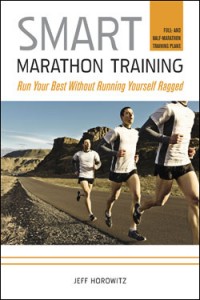
FOLLOW A COUPLE Of ESSENTIAL WORKOUTS
There are three essential workouts you should be doing as you work toward your racing goal.
One is endurance-building workout—a longer, easier run. Another is speed workout or interval training—a shorter, more intense training. The third is what we call a tempo run—a long, sustained effort that’s more intense than the easy long run, but not as intense as the interval speed run. These are the three workouts you can do every week. They are targeted to different aspects of your running and will help you move toward your goal.
Once you’re done with these three workouts, if you want to run a fourth or fifth day, you could—but I don’t see exactly what purpose it serves in terms of moving toward your goal. Again, if you just love running, and if you’re healthy, that’s fine. But if you are trying to meet goals, then you have to seek other workouts like cross training or strength training. Say you cycle for two days to complement strength. Or, if you do very targeted strength trainings, then some days you don’t have to go to the gym at all; you can do it at your home, which may take only 20 minutes. In that way, you’ll find it might not take as much time preparing for marathon as you thought it would. If you do three targeted runs per week, a couple of cycling sessions, a couple of relatively short strength trainings, then you’re being very purposeful in your training, and the result will be more efficient; you won’t spend a lot of time doing workouts that are not really helping you move toward your goal. It’s quality training, and you’ll find you have more free time.
SHOE CHOICES VS FORM
One of the hot topics about running is whether you should use minimalist shoes. I love that people are paying more attention to how they’re running and what equipment they use. I think minimalist shoes are fine; however, research shows that if you run correctly, what you wear on your feet is less important than the form you’re using. The number one thing I tell people is try to run with as light footsteps as possible. Don’t slap the ground hard. If you can run quietly, the risk of getting hurt will be much lower.
ENJOY THE RACE
Every time you cross the finish line of a marathon, it should be a celebration. You should be really thrilled with yourself, regardless of whether you hit the goal you originally set. Enjoy the experience. A marathon should give you some insights into who you are, how tough you are, how capable you are, and how strong you are—emotionally and physically.
Jeff Horowitz will be publishing his third book, “Quick Strength for Runners”, this November, in which he shares an eight-week program you can do at home to become a stronger, more efficient, injury-free runner. For more training tips, visit Jeff Horowitz’s website: http://smartmarathontraining.com/
By Alix Shutello
When I planned out the magazine’s editorial schedule for this year, this issue was slated to be about the Boston Marathon. The Marathon, you see, is a stepping stone for many who enter into the world of endurance running; it seemed appropriate to do an issue on “the” race that means so much to so many.
I’m a fan of the Marathon myself: my very first marathon was the Boston Marathon. I ran it in 4:30 back when I was 18. This year, I stood at the starting line as a spectator, excited to be taking photos of the competitors; but that day turned into a travesty. I still feel tremendous guilt that I was able to cross the finish line the day before at the B.A.A. 5K, which I ran with two very close friends of mine, and that we had such a wonderful experience on Sunday, only to have the lives of so many turned upside down on Marathon Monday.
For those who didn’t cross the finish line, there was a double sense of loss. I interviewed local Virginia runner, Ivette Booher, who was stopped just before the finish line. She didn’t know what was going on; and after time spent standing around, the athletes began to get cold. “I was one of the first people stopped at 25.78, and got cold quickly.
I also started cramping from the sudden stop and waited about 10 minutes all the while borrowing phones to try to reach my family, but I couldn’t reach them. I decided to start walking toward the finish line on a parallel road and was helped in finding the finish by a good samaritan, Jeff, from Homeland Security. He allowed me to use his phone and I was finally able to reach my husband. After that, he led me to the buses where the gear was checked. I got my things and walked back to my hotel at Copley Square.”
I asked Booher the tough question. “Are you angry? C’mon, you’ve got to be pissed. You qualified, and somebody took away your glory.” I could sense her relief, even though I knew it was a sensitive question to ask.
“Sure, I’m mad,” she said. “Now I need to train and re-qualify all over again!” Fortunately, it turned out that these runners would be invited back to race in 2014.
Booher received excellent support from family and friends, and was welcomed home like the champion she is.
She will race again in 2014…and her family will be there to support her.
CHARITY RACES FOR BOSTON
Here in the DC area, many of us in the running community gathered together. I ran in a few charity races to raise money for Boston. One runner, Alexander Cochran, who hosted a charity run (Boston Strong Run), has never competed in Boston; he would have this past year, but he missed the qualifying time by 4 minutes. So when his friend, Jamie Hoag, competed at Boston and sent him the photos of the devastation, Cochran jumped at the chance to do something for the families who were affected by the tragic bombing (see his story on page 24). The race, run along the bucolic Potomac River, was not only amazing, but was supported widely by the community, as well as Cardinal Bank and other businesses.
Many other runners and organizations have pulled together to raise money for Boston Marathon victims and their families. And this year, at the ING New York City Marathon, charity teams are being formed to raise money. Learn more at www.charityteams.org.
Charity teams are being formed to raise money for victims and their families. Visit www.charityteams.org to learn more.
Running is both a selfish act and a giving act.
When you go for a run, you relieve yourself of stress, get an endorphin high, and generally feel better about yourself when you are done.
And this helps us be better around our loved ones and friends. Wouldn’t you agree?
I have to say, there is nothing more gratifying than training for a race and completing it. The marathon ranks up there as “the” race to train for and compete in. It’s the race that pushes many to their limits—and when running the marathon is not enough, some of us move up into endurance racing and push our limits even farther, or we run multiple marathons “just because we can.”
In the last decade, the marathon has become the darling race of Americans in particular. New marathons get added each year, it seems, and some are becoming more extreme. There are off-road and cross country half marathons and marathons. It’s exciting—and to be frank, it’s just as exciting to toe the line at a local marathon or half with 200 people as it is to go to the big races with tens of thousands of people. In the end, it’s the adventure, and the satisfaction of ultimately finishing.
This year, however, the sport of running was tested at the Boston Marathon, when our lives were shaken by terrorism. I was there—thankfully not at the finish line, but taking numerous photos at the start. My neighbor, Jan, was at the finish with her sister, and I was frantically trying to find out if she was okay. There were others I knew personally who were there, and I didn’t know if they were okay. Worse, I got a call from my son’s elementary school back in Virginia that my youngest son, Dylan, was being rushed to the hospital, and I wasn’t there to make sure he was okay. My phone was exploding—calls, texts, emails, people asking me, “Are You okay?”
“Yes, I’m fine,” I said.
But I wasn’t. Between worrying about my neighbor and others I knew who were there, and the added stress of my little guy being rushed to the hospital by a neighbor, there was a moment when I thought I was going to freak out.
And I did get freaked…but after all these years of running and training, and given my personality—I moved beyond the stress and calmed down after a few heart palpitations.
I dedicated this year to running for Boston and doing what I can for other athletes and races. I ran in a couple of charity races for the Boston Marathon to be part of the community of runners here. The DC/MD/VA market is one of those hot spots for runners, triathletes and endurance/adventure racers. We are Boston Strong. Many of us are from Boston, Rhode Island and the NY metropolitan area. Many of us grew up along the Jersey Shore, as I did, and have a certain “muscle” for the extreme. I’ve lived through 9/11 and watched the twin towers fall—buildings where my parents used to work and I used to visit before they retired. I visited my Jersey Shore after Hurricane Sandy, and I stood in support of marathoners as we managed to survive Boston.
Life can be hard, unfair, and rather painful.
Runners do what we do best—we run through it, we raise money, we put our arms around each other, and we love our way through tragedy.
Be Strong.
Alix
Alix Shutello, President and CEO [email protected]
